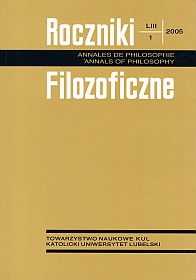Alfred Tarski’s T-Scheme as a Definitional Equivalence
Abstract
The goal of this paper is to present a way of reading Alfred Tarski’s T-scheme as a definitional – and not material – equivalence. Anil Gupta and Nuel Belnap in their book The Revision Theory of Truth (MIT 1993), develop a theory of truth and a theory of definition, which are called Revision Theories – of Truth (RTT) and of Definition (RTD). They accept Tarski’s T-sentences (such as: “snow is white” is true iff snow is white) and their central role for the signification of truth. According to RTT and RTD the centrality of Tarski’s T-sentences can be maintained only by accepting interdependent definitions. Gupta and Belnap claim that it is worthy to read the T-scheme as a definitional equivalence rather than as a material equivalence, for the former understanding allows us to solve the Liar paradox. To obtain this result, it is important to notice a structural similarity between the T-scheme and the general scheme of definition.
Gupta and Belnap reject Tarski’s demand for formal correctness of definitions and claim that it is logically justified to accept circular definitions. This is why they modify a general scheme of definition by adding a predicate which is being defined (definiendum) – e.g. an arbitrary predicate G – to the definiens, i.e. to the defining formula which occurs on the right side of the definitional scheme. A circular definition, which is constructed in such a way, is helpful in showing that different patterns of behaviour of the predicate G are similar to respective patterns of behaviour of the predicate “true”. Such a result suggests that the concept of truth is itself circular.
References
Belnap Nuel (1982): Gupta’s Rule of Revision Theory of Truth, „Journal of Philosophical Logic” 11, s. 103 16.
Borkowski Ludwik (1991): Wprowadzenie do logiki i teorii mnogości, Lublin: TN KUL.
Gupta Anil (1981): Truth and Paradox (abstract), „Journal of Philosophy” 78, s. 735 736.
Gupta Anil (1982): Truth and Paradox, „Journal of Philosophical Logic” 11, s. 1 60.
Gupta Anil (1988 89): Remarks on definitions and the concept of truth, „Proceedings of the Aristotelian Society” 89, s. 227 246.
Gupta Anil, Belnap Nuel (1993): The Revision Theory of Truth, Cambridge, MA: MIT Press.
Gupta Anil, Belnap Nuel (1994): Reply to Robert Koons, „Notre Dame Journal of Formal Logic” 35, 4, s. 632 636.
Gupta Anil (1997): Definition and Revision: A Response to McGee and Martin, „Philosophical Issues” 8, s. 419 443.
Gupta Anil (2000): On circular concepts, [w:] Andre Chapuis, Anil Gupta, Circularity, Definition, and Truth, New Delhi: Indian Council of Philosophical Research, s. 123 154. [O pojęciach cyrkularnych, przeł. Irena Trzcieniecka Schneider, [w:] Ewa Żarnecka Biały i Irena Trzcieniecka Schneider (red.), Komunikaty i Argumenty, Dialogikon, vol. XI, Kraków: Wyd. Uniwersytetu Jagiellońskiego, 2002, s. 19 44].
Gupta Anil (2001): Truth, [w:] Lou Goble (red.), The Blackwell Guide to Philosophical Logic, Oxford: Blackwell Publishers, s. 90 114.
Koons Robert (1994): Book Review: The Revision Theory of Truth, „Notre Dame Journal of Formal Logic” 35, 4, s. 606 631.
Tarski Alfred (1933): Pojęcie prawdy w językach nauk dedukcyjnych, Warszawa: Towarzystwo Naukowe Warszawskie. [Tarski 1933 zostało również wydane jako: Alfred Tarski, Pojęcie prawdy w językach nauk dedukcyjnych (1933), [w:] Alfred Tarski, Pisma logiczno filozoficzne, t. 1: Prawda, red. Jan Zygmunt, Warszawa: PWN 1995, s. 13 172].
Tworak Zbigniew (2004): Kłamstwo kłamcy i zbiór zbiorów. O problemie antynomii, Poznań: Wydawnictwo Naukowe UAM.
Woleński Jan (2003): Epistemologia, t. III: Prawda i realizm, Kraków: Aureus.
Żegleń Urszula (2000): Wprowadzenie do semiotyki teoretycznej i semiotyki kultury, Toruń: Wydawnictwo UMK.
Copyright (c) 2005 Roczniki Filozoficzne

This work is licensed under a Creative Commons Attribution-NonCommercial-NoDerivatives 4.0 International License.





